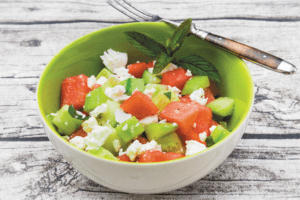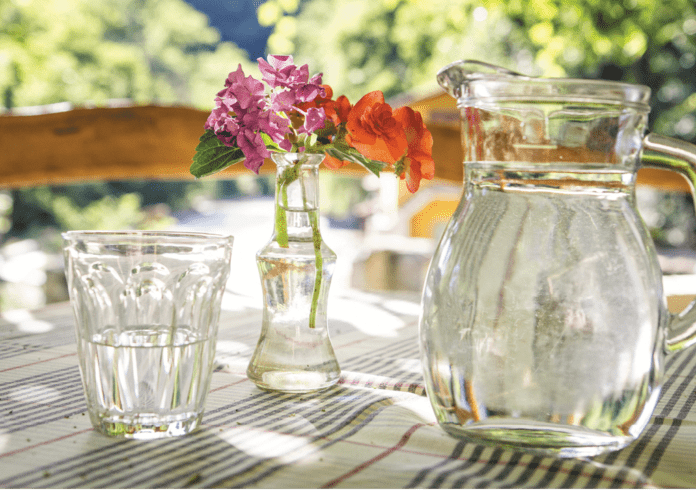It’s hot out! High temperatures increase the risk of dehydration. Fluids are critical to optimal body function. They help regulate body temperature, control blood pressure, deliver nutrients and oxygen to cells, and aid proper functioning of the gastrointestinal system. When fluid levels drop, a wide variety of systems in the body are affected. Knowing the signs and symptoms of dehydration—and how to avoid them—can get us safely through the heat of summer.
Dehydration Defined. Dehydration occurs when you lose more fluid than you take in. It can lead to everything from minor cramps and heat exhaustion to seizures and potentially life-threatening heatstroke or shock.
Thirst is one way the body alerts us of low fluid levels. “Drink to satisfy your thirst,” says Klemens Meyer, MD, a nephrologist and director of Dialysis Services at Tufts Medical Center. Other symptoms are fairly general and include dry lips, mouth, or tongue; headache, dizziness, or lightheadedness; fatigue or lethargy; lack of focus; muscle weakness or muscle cramps; and rapid breathing. Urine color is a possible indicator of hydration in children and young adults, but not necessarily in older adults. When hydrated, urine is light and straw-like in color. Very dark colored urine is a sign of dehydration. “If your urine is dark, drink water to make it lighter, but not so much that it looks like water,” says Meyer.
Dehydration Risks. We normally lose fluid in sweat, urine, and our breath. Other causes of fluid loss include diarrhea and vomiting. Illness and certain medications (including laxatives, oral medications for type 2 diabetes, and diuretics) can increase risk for dehydration. Athletes who sweat a lot for a significant period of time require increased fluid intake.
“Although thirst is a good indicator to drink water to prevent dehydration in most people,” Meyer says, “the very young and the very old may be the exception.” Infants and young children, who don’t have a lot of body mass, are sensitive to even small amounts of fluid loss, and they don’t have the ability to clearly express their thirst. The body’s fluid volume decreases with age, and so can the ability to sense thirst, so older adults are at higher risk of becoming dehydrated. On top of that, studies show adults ages 60 and older consume about two fewer cups of fluid a day than younger individuals.
How to Hydrate. Fluid needs depend on many factors, including body size, age, activity

Fluid packed fruits and vegetables—like the watermelon and cucumber paired with feta and mint in this salad—add to hydration.
level, climate, and diet. Because needs are so individual, there are no recommended intake levels that apply to everyone. Instead, the U.S. National Academies of Sciences Institute of Medicine has set an “Adequate Intake” level. In addition to the fluids we get from foods (especially fruits and vegetables), men should, on average, consume at least 12 cups of fluid a day from water and other beverages. Women should have a minimum of nine cups. Consider putting that much water in a container at the start of the day and trying to get through it by day’s end.
Water is a great choice, but other unsweetened beverages, such as low-fat or fat-free milk and fortified soy beverage, can support fluid intake while helping us reach our dietary intake recommendations for different food groups and nutrients. While electrolyte drinks are advertised to help keep you hydrated, studies have shown electrolyte loss through typical physical activity is generally small, so these (often sweet) beverages are unnecessary for most situations.
Spruce up water with a splash of fruit juice or slices of fresh or frozen fruits and/or fresh herbs. Try a sparkling or mineral water for a change (just be sure there are no added sugars). Unsweetened coffee and tea are good options as well and can be served over ice. Almost all fruits and vegetables have high water contents, so include plenty of water-rich seasonal or frozen fruits and vegetables, like watermelon, strawberries, cucumbers, celery, and tomatoes in your dietary intake.
Take the heat off this summer by ensuring you consume refreshing fluids and water-rich produce, and be on the lookout for signs of dehydration.
Choose Water. Drinking water is a healthy way to stay hydrated.
Add Flavor. If you want variety, add flavor with sliced fruits, veggies, and/or herbs, or choose sparkling varieties, plain coffee, and tea.
Avoid sugar-sweetened varieties. Sip Consistently. Keep a water source nearby to encourage all-day sipping. Consider starting the day with a container of 12 cups for males and 9 cups for females.
Know the Signs. Thirst, dry mouth, fatigue, dizziness, and headache may be signs you are dehydrated.
























